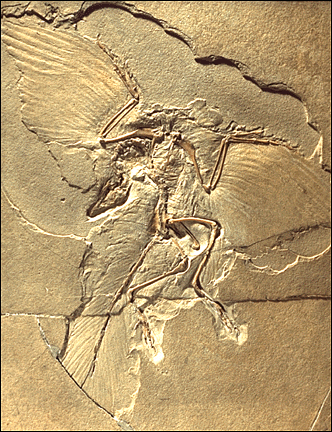Tikémi
lambeosaure


Nombre de messages : 193
Age : 40
Localisation : Bruxelles
Emploi : doctorante
Loisirs : lecture, puzzles
Date d'inscription : 07/06/2006
 |  Sujet: Un dino pêcheur et de la poiscaille dans l'Utah Sujet: Un dino pêcheur et de la poiscaille dans l'Utah  Lun 23 Avr - 15:24 Lun 23 Avr - 15:24 | |
| Un gisement américain vieux de 200 Ma a livré des restes d'un gros théropode, une nouvelle espèce de requin, et de nouvelles espèces de poissons et de plantes, ainsi que des empreintes. Apparemment ce théropode, qui semblerait proche de Dilophosaurus, était un pêcheur redoutable qui se nourrissait de requins et de poissons protégés par des plaques osseuses. Le lien n'est pas très clair et laisse sur sa faim, mais c'est tout ce que j'ai trouvé pour l'instant  : http://dsc.discovery.com/news/2007/04/20/sharkeatingdino_din.html?category=dinosaurs&guid=20070420143030 (2 pages) | |
|
damien35
bébé dino

Nombre de messages : 44
Age : 38
Localisation : 35 (près de Rennes)
Emploi : Etudiant en géosciences
Loisirs : Foot, fouille
Date d'inscription : 30/05/2006
 |  Sujet: Re: Un dino pêcheur et de la poiscaille dans l'Utah Sujet: Re: Un dino pêcheur et de la poiscaille dans l'Utah  Lun 23 Avr - 21:11 Lun 23 Avr - 21:11 | |
| | |
|
Tikémi
lambeosaure


Nombre de messages : 193
Age : 40
Localisation : Bruxelles
Emploi : doctorante
Loisirs : lecture, puzzles
Date d'inscription : 07/06/2006
 |  Sujet: Re: Un dino pêcheur et de la poiscaille dans l'Utah Sujet: Re: Un dino pêcheur et de la poiscaille dans l'Utah  Mar 24 Avr - 17:35 Mar 24 Avr - 17:35 | |
| Sympa le lien  Quant à moi j'ai l'abstract parlant du théropode : Kirkland, Milner and Nesbitt, 2005. The case for theropod dinosaurs exploiting fish as a major food resource during the Early Jurassic. Tracking dinosaur origins - The Triassic-Jurassic Terrestrial Transition, Abstracts Volume: 9-10. Following the extinction of phytosaurs and metoposaurs (semi-aquatic predators) at the end of the Triassic, there is gap in the record of large semi-aquatic fish-eating tetrapods. The earliest Jurassic record of a large semiaquatic predator is the crocodilian Calsoyasuchus from the Kayenta Formation. With few taxa taking advantage of fish as a food source, we suggest that large theropods may have fed on fish in the Early Jurassic in the western United States. The Whitmore Point Member of the Moenave Formation and the basal Kayenta Formation preserve evidence of extensive lake systems across southwestern Utah and northern Arizona. Although herbivore tracks are relatively common in more upland eolian facies, theropod tracks dominate almost to the exclusion of other ichnotaxa in the marginal environments of these lakes. The most common large theropod ichnotaxon is Eubrontes, which is usually referred to as the track of a large coelophysoid theropod such as Dilophosaurus. The near-complete absence of herbivorous dinosaurian ichnotaxa from this facies begs the question, what did these large theropods eat in this habitat? The fish from the Whitmore Point Member include abundant, heavy, ganoid-scale-covered semionotids of relatively large size (30-60 cm) as well as large coelacanths (~2 m), hybodont sharks (~1 m), and lungfish (~1 m). These fish could have served as a food source for large predators, as comparably sized salmon do for bears today. Bones and teeth of theropods large enough to produce Eubrontes tracks have been found within the same beds as these Whitmore Point fish. The theropod remains cannot be attributed to a specific theropod taxon at present. Most of the long, slender, awl-shaped teeth display a distinctive wear pattern, having the serrations along the anterior and posterior carina that are worn off from the tip of the tooth to the base of the crown. The only teeth the authors have observed with similar wear are those of Spinosaurus, a theropod dinosaur that many paleontologists agree was probably a piscivore to some degree. We hypothesize that this kind of wear was produced by the teeth penetrating the "chain mail" of heavy ganoid scales covering the semionotid fish. In the case of the St. George theropods, the fish would be Semionotus; for the mid-Cretaceous Spinosaurus, the fish would be Lepidotes. The hard enamel covering on the scales would rapidly wear the enamel on the teeth. Additionally, Dilophosaurus and Spinosaurus share the following characters that may be adaptive for piscivory: moderately long arms with raptorial claws, posterior nasal openings, slim jaws, and anteriorly expanded jaws with long, slender teeth (a rosette). Similar jaws are present in a number of extinct and extant aquatic and semiaquatic fish-eating predators (e.g., crocodilians, phytosaurs, champsosaurs, and pliosaurs). A slender jaw displaces a minimum volume of water when shut rapidly, and the rosette of teeth at the front maximizes the area for catching fish. Posteriorly placed nasal openings might permit the end of jaws to rest in water with head in a vertical "striking" position. Furthermore, the recently documented myriad of theropod swim tracks in both the Whitmore Point Member and lower Kayenta Formation indicates that theropods were regularly entering the lakes to water depths that would at least partially buoy up their bodies. Apparemment ils auraient une tonne de boulot encore à faire à St.George, et tout ça avance lentement (les os sont très fragiles). | |
|
Contenu sponsorisé
 |  Sujet: Re: Un dino pêcheur et de la poiscaille dans l'Utah Sujet: Re: Un dino pêcheur et de la poiscaille dans l'Utah  | |
| |
|
